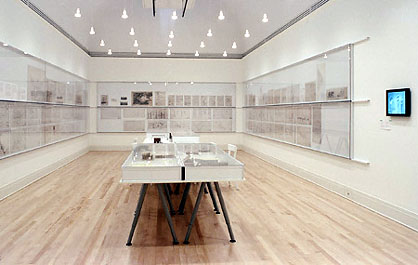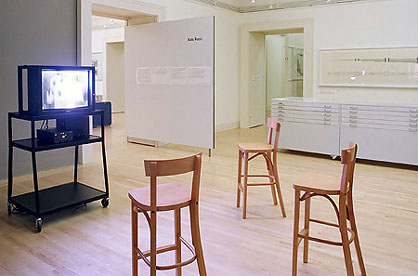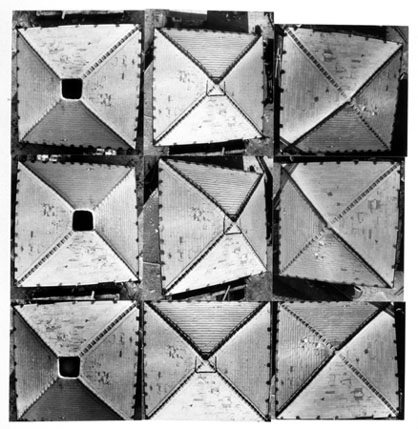|
|
| home > esposizioni |
| The
light archive. An interview with Mirko Zardini Roberto Zancan (with Andrea Guardo and Alexis Sornin) |
||||
| ARCH'IT
presenta, a cura di Roberto Zancan (da qualche mese ospite del CCA,
Centre Canadien d'Architecture di Montreal), una breve serie di riflessioni
sulle principali esposizioni di architettura che si sono tenute in nordamerica
nel corso dell'anno appena trascorso. Si tratta di un percorso articolato
e ricco di interessanti spunti di riflessione che parte da un'intervista
a Serge Belet, responsabile
tecnico per le esposizioni del Centre Canadien d'Architecture, in merito
alla mostra Herzog & de Meuron: Archéologie de l'imaginaire,
in arrivo a Basilea e Rotterdam dopo l'inaugurazione presso il CCA;
prosegue con una recensione, pubblicata originariamente sull'autorevole
"Artforum International" a firma del critico d'arte Scott
Rothkopf, della mostra Scanning: the aberrant architecture of
Diller + Scofidio, allestita al Whitney Museum di New York e già
presentata sulle pagine di ARCH'IT con un'introduzione di Aaron
Betsky e un commento di Alicia
Imperiale; e si conclude con una vivace intervista a Mirko Zardini,
curatore di Out of the box, illustrata da un ricco reportage
fotografico della mostra che ha offerto al pubblico un'ampia selezione
degli archivi di Gordon Matta Clark, Aldo Rossi, Cedric Price e James
Stirling, recentemente acquisiti dal CCA. [PG] |
||||
| The
following interview is intended to conclude some reflections regarding
important architectural exhibitions held in North-America during the
past year, whilst a new one is about to begin. Starting with the interview
to Serge Belet –Exposition and Installation Chief- on the Herzog
& de Meuron: Archaeology of the Mind, we enclose the translation
of review to the exhibition Scanning: the aberrant architecture of
Diller + Scofidio, by Scott Rothkopf, previoulsy appeared on Artforum
International. By juxtaposing different experiences and opinions, we tryed to provide an insight on the cocenption and realisation of a group of important architectural events, ultimately capturing comments by those who are outside the architecture environment. In doing so we aimed at unveiling what happing in this transition phase, from the enphasis on the figure of the "architect-master" and the growing financial crisis affecting important cultural institutions. The two aspects are only apparently disjointed, if we agree with the hypothesis that contemporary model of culture-production seems more concern with promoting new star-system artists without creating an appropriate meaningful framework. This role seems to be accepted even by the most prestigious institutions, that constrained by management and financial problems, are no longer able to support innovative trans-cultural research programmes. Before leaving the reader to his own reflections, wondering if there will be a chance for an appropriate debate, this is what Mirko Zardini told us during a warm evening of this strange Canadian autumn... |
[25jan2004] | |||
| ROBERTO
ZANCAN: As you already know, this interview will be part of a series
of brief commentaries on the most relevant exhibitions held in north-America
during this year. This serie includes an interview about the exhibition
of Herzog & de Meuron and the review on Diller + Scofidio at Whitney…
I wonder if, after all, this is another monographic exhibition? MIRKO ZARDINI: No… This exhibition is not monographic, nor a collection of monographic exhibitions. I don't think monographic exhibitions can offer today interesting ways to explore problems relating to architecture and the built environment. That kind of exhibitions is often too much loaded with the Star-system attitude and self-promotion. The concept of Out of the Box is to initiate a reflection about the seventies, starting from the documents of the CCA archives and a contemporary point of view.  At the CCA we are in the middle of a process of enquiry and research on this theme so the exhibition is intended as an opportunity to reveal the process behind the enquiry and objects of our on-going investigations. In this sense, the installation too reflects the idea of process, and the fact that material of our research can change, be transformed, substituted, can lead to completely different questions, as we can change our ideas and correct points of view...in directing our enquiries. The exhibition acts as display tool for the intermediate state of such investigations. So this is not an exhibition as a way to "celebrate the subject"... The exhibition is based on a clear intention, which is to give a more articulated and dialectic view of the seventies. We purposefully justapose on one side Price and Matta-Clark and on the other Rossi and Stirling materials. The presence of Matta-Clark, in particular, is very interesting as we wanted to explore the architectural environment in which he started his reflections and the production of his first works, and relate them to the cultural debate of the seventies.  out of the box: price rossi striling + matta-clark, Canadian Centre for Architecture from 22 October 2003 to 6 September 2004. View of the installation, Gallery 6. Photo Michel Legendre © Canadian Centre for Architecture, Montréal. ...A former employee of CCA told me he disagrees with the decision of missing the opportunity of having four different exhibitions instead of one. All these archives are exposed at once... Maybe that's true, I prefer to present them all together with different hypothesis and conflicts coming out from very different points of view on the seventies. You would not get the same effect if you saw them independently. Yet there is also a strong reflection coming from present days, that is informing this exhibition. In this sense the exhibition is not, once again, an archival exhibition, but it starts from contemporary problems. |
||||
| The
issues we are facing today relates to political and social consequences
of architecture, problems relating to the capacity of the discipline
to confront itself with problems, perhaps art and the artists, more
than architects. So there are many contemporary problems you can identify by looking at these works. Yet the framework we are providing is, somehow, a traditional one, where four architects' works are presented in a systematic way. Their thoughs intertwine with issues extracted from contemporary discourses only to enable a retropsective analysis of the seventies that is the core of the research.  out of the box: price rossi striling + matta-clark, Canadian Centre for Architecture from 22 October 2003 to 6 September 2004. View of the installation, Gallery 5. Photo Michel Legendre © Canadian Centre for Architecture, Montréal. So what is the relation with the archives, and what is the contribution of the curators? Starting an investigation in the archive, we decided to bring in people like Hubertus von Amelunxen, Marco De Michelis, Philip Ursprung, Anthony Vidler, Mark Wigley, who have already worked on these architects and artists by asking them to confront their opinions with the material of the archive. This is the reason why we involved the external curators who have already been studying these architects and artist in different ways, and brought them back to the archives to verify their hypothesis. In order to enable them to work with these materials, however, the internal curators, Louise Désy, Pierre-Édouard Latouche, Gwendolyn Owens, Howard Shubert, have had a crucial role in helping them to develop this insight (view) into the archives... Is there an important view coming out, so far? What has come out very clearly is the potential of the questions derived by the juxtaposition of different hypothesis from the architects and curators works. Price's ideas, on which Mark Wigley is working, deliver a new concept of architecture sensible to social, political and economical transformation. According to this, the building could be considered as anti-building, something conceptually far away from the traditional view within the discipline. An anti-building would be ephemeral, and as such could be destroyed after ten years; it would be capable of changing itself, some kind of vision which could be interesting to reconsider today. On the other side we have Stirling and his ideas on history, the city and context. His attitude is more sensible to the material outside of the context, the idea of listening to the context, an attitude that is exemplary of a different period of the discipline. Vidler is trying to supercede the big distinction between the first and second Stirling, between the modernist and the classicist Stirling, I think that such an operation will deliver his profile as having been based mainly on the principle of unity. De Michelis is continuing his reflections about Rossi, reinforcing a specific personal investigation on the continuity of his work. Finally, Matta-Clark's works brought back to the architectural context by Philip Ursprung and Hubertus Von Amelunxen are very productive, especially for the architectural debate.  out of the box: price rossi striling + matta-clark, Canadian Centre for Architecture from 22 October 2003 to 6 September 2004. View of the Installation. Photo Michel Legendre © Canadian Centre for Architecture, Montréal. I have the feeling that this exhibition looks totally different from what has been done, so far, at CCA. Some people working here told me that they could not recognise the exhibition space anymore! The process and the aesthetic involved for this exhibition are completely different from the previous ones. Out of the Box has a different strategy that derives from a completely different attitude, that is more appropriate to the idea of an informal way to produce and display results working with Louis-Charles Lasnier, a young Montréalese architect and the designer of the exhibition. We wanted to create a sophisticated atmosphere using very informal devices and modalities. That is the reason why we have metal panels with magnets, we have pieces of paper fixed on the walls with green masking-tape, or staples. Certainly the differences are very striking in relation to the other exhibitions. I suppose it could be more different! I guess you are right, but as I told you, the strategy is still in-progress. What if you had had chances to spend more money? I mean was this idea influenced by the need to remain within the budget? I never thought of that because this situation has been created by us... Could you have more resources then? |
||||
| Even
if I had had more resources I would have gone in the same direction.
I think there's an ethical attitude against the idea to invest so much
money in the installation, in this situation. We prefer to invest the
resources in the research and in the collection. In relationship to the differences between this installation and the others, I asked people working with you to give me some questions for you. Everybody has had kind words for you, but I think they did not tell the full story. I believe you put them under pressure, in a way you made them work in a different way... That's true, they are not used to work this way. Yet they are happy with the results... Generally the time frame for an exhibition, at CCA, is consistently larger than six months. So we had to develop a different strategy. The people at CCA are an incredible team. They are competent, and have been very enthusiastic to work in a different way. But for this project you know where you start but you don't know, yet, where you could end up!  out of the box: price rossi striling + matta-clark, Canadian Centre for Architecture from 22 October 2003 to 6 September 2004. Analogous composition juxtaposing the funerary chapel at Giussano, the entrance gate to the 1980 Architectural Biennale, Il Teatro del Mondo, and a hotel project for Cannaregio west, Venice. Collection Canadian Centre for Architecture, Montréal / Fonds Aldo Rossi. Regarding the installation, and its details such as the drawers, the magnets for pinning-up the drawings, the plastic envelopes, paperclips...It looks like the archives have come up from the vaults into the exhibition space. All the curators were fascinated by this project, and they agreed with the idea of reproducing some kind of "archival" ambiance. Our intention was to reproduce the atmosphere of the archives but to escape from recreating any archives at the installation. Cedric Price's setting is a metaphor of his studio, the white room he was working in. With Aldo Rossi we played with the theme of archive in a more conventional way, presenting many framed drawings. At the same time, we pay an homage to the Zurich period displaying the chests of drawers with the drawings inside. As for Stirling we refere to his small studio in a ninety century building in London, an informal atelier. With Matta-Clark, of course, the reference was more to art installation, as this best relates to the material we are presenting. |
||||
 out of the box: price rossi striling + matta-clark, Canadian Centre for Architecture from 22 October 2003 to 6 September 2004. A W-Hole House. Collection Canadian Centre for Architecture, Montréal / On deposit from the Estate of Gordon Matta-Clark © The Estate of Gordon Matta-Clark. In this sense the exposition looks really "material". It looks like we are brought back to the architectural practice, to the draughting table... There is an effort to stress different media. We try to underline different instruments used by the protagonists. For Price, the idea of public communication is underlined by the use of film, panels, and as incredible amount of drawings. For Rossi, the presentation is more conventional, ever is in Rossi's style. With Stirling we celebrate the terrific sketches of the CCA collection. For Matta-Clark, we present six films, some artworks and some texts and photographs of less known Anarchitecture production, a very interesting contribution to the study of his work. But on the contrary the installation is very "light"... We tried to maintain some idea of lightness. Not only in the installation but as an attitude to everything. For example, in order to have a very "light" and informal installation we have introduced chairs in every room, so you can seat there and have a look at the documents in different ways. Visitors can spend their time in the exhibition in different positions. They might need some hours to be able to look at the documents that are on the tables, they can seat and take notes, read the books on the table, alternatively they might pay just a quick glance to the galleries. They might wan to come back to it as this is an exhibition that is expanding into different parts of CCA, in the library, and through the conference series and seminars program.  out of the box: price rossi striling + matta-clark, Canadian Centre for Architecture from 22 October 2003 to 6 September 2004. Cedric Price, Architect, 1934-2003. Model of Fun Palace, London. Collection Canadian Centre for Architecture, Montréal. This is an living expo... but what about the IKEA furniture? IKEA furnitures help to dessacralize the attitude toward traditional exhibitions. We did not wanted the over design exhibition. We preferred to use standard things that you can also find at home, in the office, and their combination with the gallery space is quite interesting. It is not about the things in themselves, it is about how you use them. And what about the seminar... Because of the on-going research project, we wanted to invite north-American universities to come here and take advantage of the exhibition as to explore the resources of the CCA. It will be possible to organise some visits to the archives, and we are creating a room for seminars near the exhibition space. In this way the exhibition will contaminate other parts of the CCA. Exhibition and research develop alltogether. We are starting from some questions, and we don't pretend to produce answers, at this stage. We prefer to stimulate other good questions. One of the main problems is that if you have no good questions, you can't have good answers. So the idea is to produce good questions. Perhaps they look contradictory. Perhaps the so-called message does not look clear enough. However, as Gordon Matta-Clark wrote, "this is what we can offer you… confusion guided by a clear sense of purpose", and this is the real project behind the exhibition. Why orange... I have always been a great supporter of the Dutch soccer team... Jokes apart, all people working at the exhibition liked the colour... it was a democratic choice! Colours, big text, slogans... This reminds me of the exhibition on Asphalt by Zardini! Perhaps. Although dealing with a different problem, the attitude is the same. First of all also here we have different ways of looking at the exhibition. As I mentioned you can spend there 5 minutes, one hour or five days and you know what's going on. Irony is an other recurring ingredient. The magnets, the green masking tape, the emphasis on the big photos of the transportation of the materials or the insurance contracts for transportation framed and exhibited... The exposition space at CCA is not very flexible, and somehow hard to be transformed... yet this aspect is something to play with. Thank you and bonne chance! Thank you. |
||||
| > CENTRE CANADIEN D’ARCHITECTURE | ||||